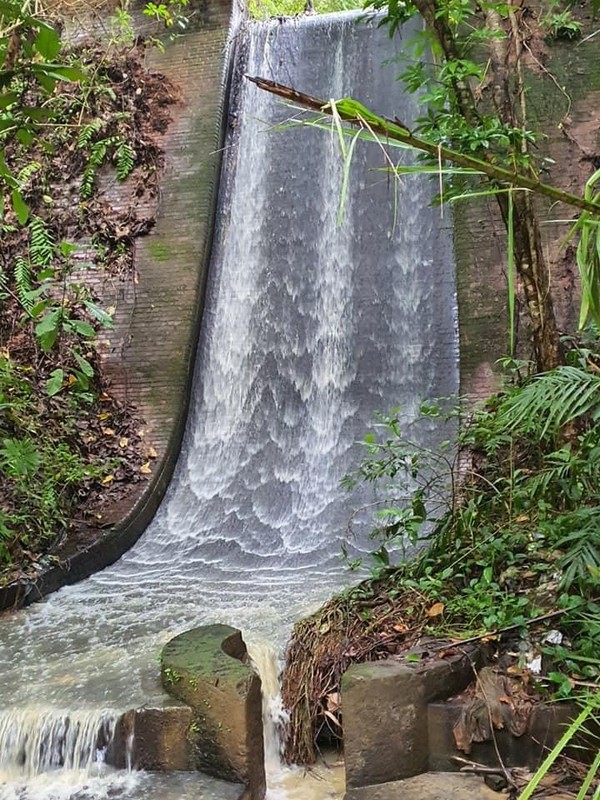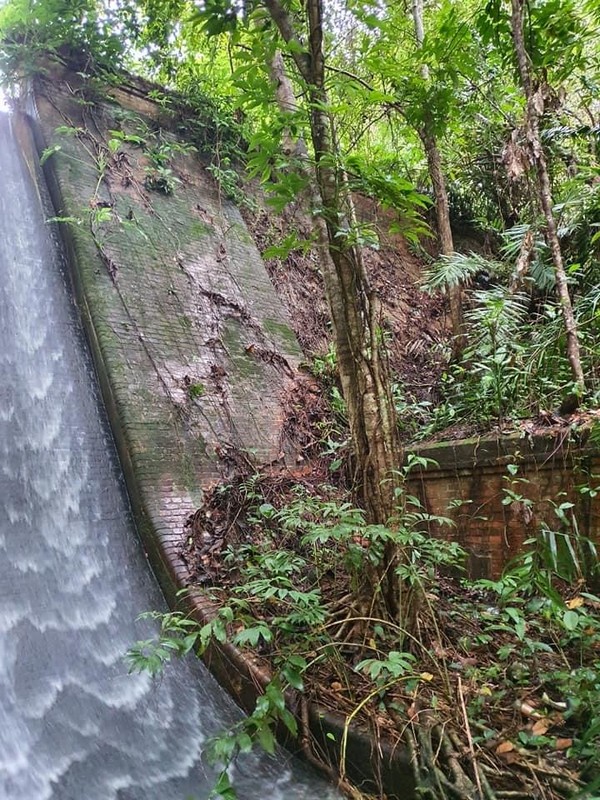Discovery in Miri Coined "Japanese Waterfall" - But Could it be The Forgotten "Salome Dam"?
Primary tabs


Photo from social media from "Choo Choo Pau"
In recent weeks, a lot of news, talk and photos spread over social media of a discovery of a curious water feature structure deep in the thick jungles of Canada Hill, which people coined "Japanese Waterfall" due to its water flowing features and nothing more than a link to the fact that Miri was once occupied by the Japanese during World War II.
The structure is a large wall of bricks curving upwards at an angle of up to about 80 degrees, with water flowing down it. Made of what appeared to be bricks, it looks to be very well made, is still in remarkably good condition with smooth bricks all well placed together and its corners tapered off nicely, a testament to construction workmanship of the old. Water flowed down the channel and was kept in between carefully shaped walls on its sides.

Photo from social media from "Choo Choo Pau"
What is it?
At first glance, it looked like a narrow water dam to me, or at least, some sort of a water redirection / overflow channel for a reservoir or water cachement. The structure is made of bricks, carefully and neatly arranged and constructed with excellent workmanship. The bricks are smooth, neatly packed, and the corners of the bricks are rounded at the sides. There appear to be one column pillar at the base, with a leather strap tied around it.
Who built it?
At this point no one knows for sure. But strictly based on pictures and having not seen this in person yet I feel that this does not look like building material that the mid-20th century Japanese invading army would have had access to. The Japanese army during World War II were famous for having good carpentry, making use of wood (of which there were plenty of in Miri during those days) and even in Japan itself architecture was mostly wood and stone. During the war, scarcity was rife, and structures were mainly makeshift temporary or existing structures were made use of instead. One would be hard pressed to find any reason why the occupying Japanese of the time would be working on constructing a water dam / water redirection effort while they were busy dealing with being bombarded by the U.S. forces.
Since this structure is located at Canada Hill, which - before the war - was occupied by oil workers from all over the world, it is safe to deduce that this might be a flow control or dam that was built by the dwellers or engineering crew who worked near the oil fields dotted along Canada Hill to control water flow over key areas of drilling. This was a time when the industry was gaining momentum, Miri was booming, and certainly materials such as bricks would be in good if not somewhat steady supply around this time. In the colonial times they were known to use bricks as construction material.
It's possible that when the war happened, people were forced to abandon the drilling areas (drilling sites and oil wells were destroyed specifically to prevent the Japanese getting their hands on them) and, possibly neglected over time the forest grew around it and the dam was eventually forgotten. Certainly the occupying Japanese could have made good use of the dam too during the period of occupation.
Could this be the "Salome Dam"?
Another evidence that suggests this would be a dam is in the Gymkhana Club documents it was mentioned that GCM was moved next to a "Salome Dam", all the way back in 1915. This was the only record so far we have of such a dam that we know of for now in historical accounts. The only way to verify this is if there were any records of where the GCM was located back in 1915-1917.
Conclusion
Based on my observations strictly through online media photographs only, and without having had the chance yet to see it in person, I find that this is very likely a dam, built to control flow of water, possibly by the early people pre-World War II necessitated for water redirection or flow control for the purposes of drilling.

Photo from Austinpostcard.com of a similarly designed dam from around 1900s.
And we could find pictures of dams around that time period that were constructed similarly.
Likely not constructed by the Japanese, and just as likely not for the purpose of a 'waterfall' at least in the recreational sense. The construction of the dam seemed too polished to be something that was meant to be a war effort, but this would be best left to archaeologists to determine its origin and date of construction.
Unfortunately, there is a lot of interest and as a result a lot more people are now visiting this area, and based on the latest photographs there are already signs of damage and vandalism, the column at the base had toppled and the leather strap appeared to be missing, and there is at least one video showing what looked like a pottery item found at the area.
View Larger Map
Please note, its location is an approximation at this point in time.
 ...
... The Paragon Lutong Hotel is an elegant hotel and the latest landmark in the bustling commercial and residential township of Lutong
The Paragon Lutong Hotel is an elegant hotel and the latest landmark in the bustling commercial and residential township of Lutong Taman Seroja Food Center is located at Jalan Setia Raja. It is one of the older food centers in town selling muslim food and beverages and popular patronage among many Mirians.
Taman Seroja Food Center is located at Jalan Setia Raja. It is one of the older food centers in town selling muslim food and beverages and popular patronage among many Mirians. Taman Awam Miri or Public Park is about 3km from the city center along the Miri-Bintulu Road.
Taman Awam Miri or Public Park is about 3km from the city center along the Miri-Bintulu Road. 